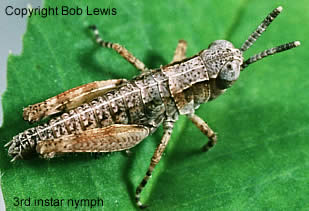

Nymph Description: Colour variable, ranging from dark grey to brown but never green. In early instars the antennae have whitish- to pale-coloured tips (see above). The upper margins of the thorax have prominent white streaks along their entire length. In side-on profile, the body is generally mottled in appearance and does not have any distinct pattern. Nymphs pass through five instars, the approximate sizes of which are: 0.4 cm I-instar, 0.6 cm II-instar, 0.8 cm III-instar, 1.0 cm IV-instar and 1.2 cm V-instar.
Confusion with other species: Wingless grasshoppers are sometimes found in association with a range of other species such as Yellow winged locust, Eastern plague locust, Yellow bellied grasshopper, Mountain brown, Small plague grasshopper (Austroicetes cruciata) and occasionally Australian plague locust. Confusion with other species is most likely to occur when adults of the short-winged form of Wingless grasshopper are interspersed with fifth-instar hoppers of the species of locust mentioned above. Fortunately, the venation of the wings should allow for easy separation (see Identifying wingless and winged species). Wingless grasshoppers do not eat grasses - only native and introduced forbs. The survival of nymphs is thought to be higher in degraded pastures with abundant broad-leaf weeds.
Further information on this species: Description of adult
